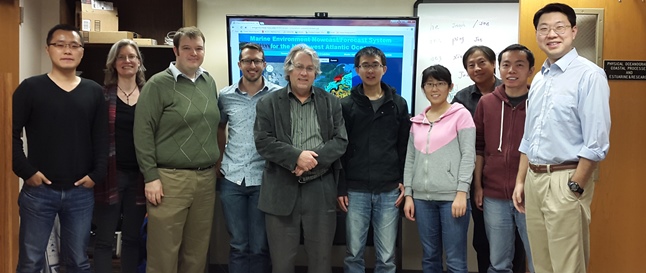News
OOMG Newsletter: Subscribe and Access the ArchivesWe publish a monthly e-newsletter to inform collaborators, funders, and the public of our activities, upcoming events and seminars, and related news. To subscribe, please use the form below. You can unsubscribe at any time by clicking the Unsubscribe link at the bottom of each e-newsletter. Email Marketing You Can TrustTo view past issues of the OOMG Newsletter, click the links below. Dr. Kerry Emanuel visits OOMGDr. Kerry Emanuel (center), the Cecil and Ida Green Professor of Atmospheric Science at the Massachusetts Institute of Technology, visited OOMG on April 17, 2015. He was the invited speaker of "The Nature of Science: A Town Hall by Greg Fishel" program at the NC Museum of Natural Sciences, and gave a presentation on North Carolina Hurricanes: Past, Present and Future on April 16. Visiting NCSU's Department of MEAS on the 17th, he also gave a departmental seminar on Radiative-Convective Equilibrium and Its Instability: Implications for Weather and Climate. 
from left to right: Xiangming Zeng, Jennifer Warrillow, Joseph Zambon, Austin Todd, Kerry Emanuel, Chuanjun Du, Ping Zhai, Zhiren Wang, Yanlin Gong, and Ruoying He New OOMG MembersWe welcomed Dr. Zhiren (Joseph) Wang as the newest postdoc research associate in early January. Dr. Wang, who received his PhD from Rutgers University in 2013, is working on modeling blooms of the red tide-causing alga Alexandrium fundyense in the Gulf of Maine. Also joining OOMG in January is Dr. Chuanjun Du, a visiting scholar from Xiamen University in Fujian, China. Dr. Du will be with us for five months, while he compares the marine biogeochemistry of the South China Sea to that of the Gulf of Mexico and Caribbean Sea.GoMRI Science Featured at the Bush Presidential Library and MuseumAn interactive exhibit at the Bush Presidential Library and Museum, located at Texas A&M University, allows visitors to "Make Your Own Oil Spill." Visitors can "spill" oil in the Gulf of Mexico and South Atlantic Bight by tapping a touch-screen display, then watch the program map the dispersal of the oil based on bathymetry, currents, and winds. The visualization is part of the exhibit "Offshore Drilling: The Promise of Discovery." Gulf of Mexico Integrated Spill Response (GISR) team: Ruoying He (North Carolina State University) and Oliver Fringer (Stanford University). Graphics and animation by Gene Cooper (Four Chambers Studio). Funded by the Gulf of Mexico Research Initiative (GoMRI). Debra Hernandez, Executive Director of SECOORA, visits OOMGDebra Hernandez, Executive Director of the SouthEast Coastal Ocean Observing Regional Association (SECOORA), visited the OOMG in March 2014. 
from left to right: Xiangming Zeng, Zhigang Yao, Austin Todd, Debra Hernandez, Ruoying He, Joseph Zambon, Yanlin Gong, and Yizhen Li. (not pictured: Zuo "George" Xue, Jennifer Warrillow) Gulf of Mexico Drifter TrackerThis display animates the NCSU SABGOM model-simulated trajectories of surface floats released within the South Atlantic Bight and the Gulf of Mexico on the day of the Deepwater Horizon oil spill (April 20, 2010) and where they would drift for the following six months. To see the trajectory of a surface float, click a starting location within the light shaded area in the Gulf of Mexico or the South Atlantic Bight. The drifter track will automatically animate along a precomputed path (indicated by a black line). Project team: Ruoying He, Zhigang Yao and Zuo Xue (North Carolina State University); Jean Ann Bowman and Piers Chapman (Texas A&M University); and Oliver Fringer (Stanford University). display design: Gene Cooper (Four Chambers Studio) Funded by the Gulf of Mexico Research Initiative (GoMRI). Ocean Glider surveying off Southeast Coast and Marine Protected AreasThe University of South Florida's Teledyne Webb Research Slocum Glider was deployed off the Atlantic coast of Florida to detect hotspots of reef fish activity in and around marine protected areas. The regional-scale nowcast/forecast ocean modeling system developed by the OMG group at NCSU will assist the glider's navigation as it travels north along the Atlantic continental shelf, heading as far north as South Carolina. Dept. of Marine, Earth, and Atmospheric Sciences Fall 2013 NewsletterBiology and Physics Combine To Explore and Understand Larval Dispersal Around Methane Seeps Coordinated Glider Efforts On The North Carolina Shelf Gliderpalooza 2013SECOORA member institutions participation in Gliderpalooza 2013. Article |
